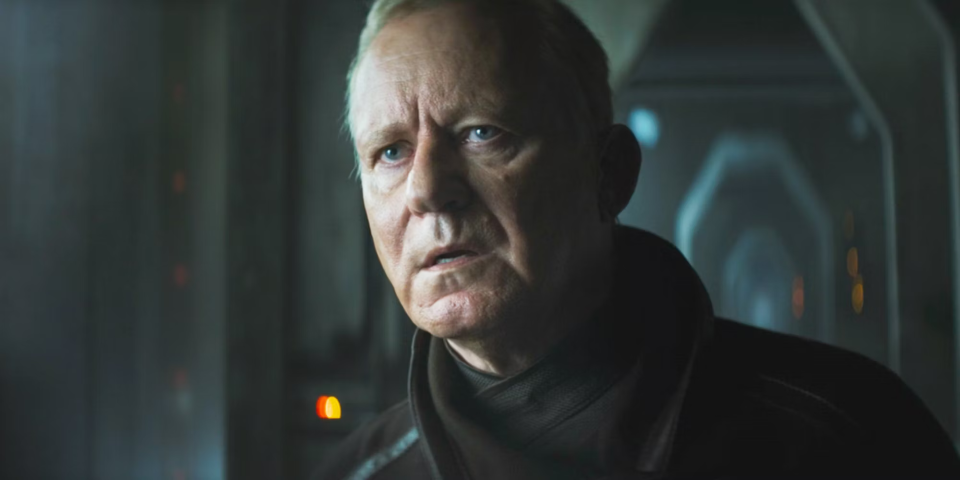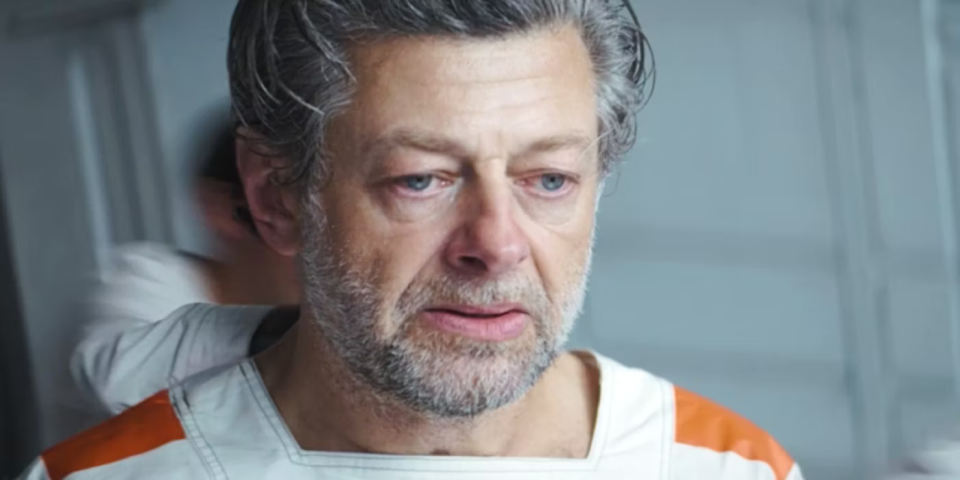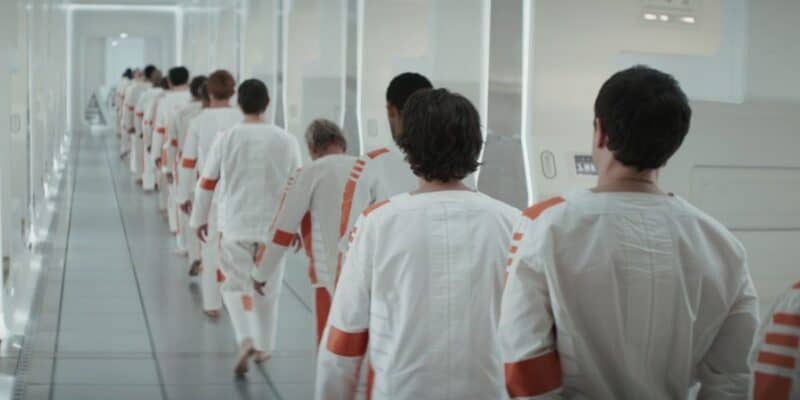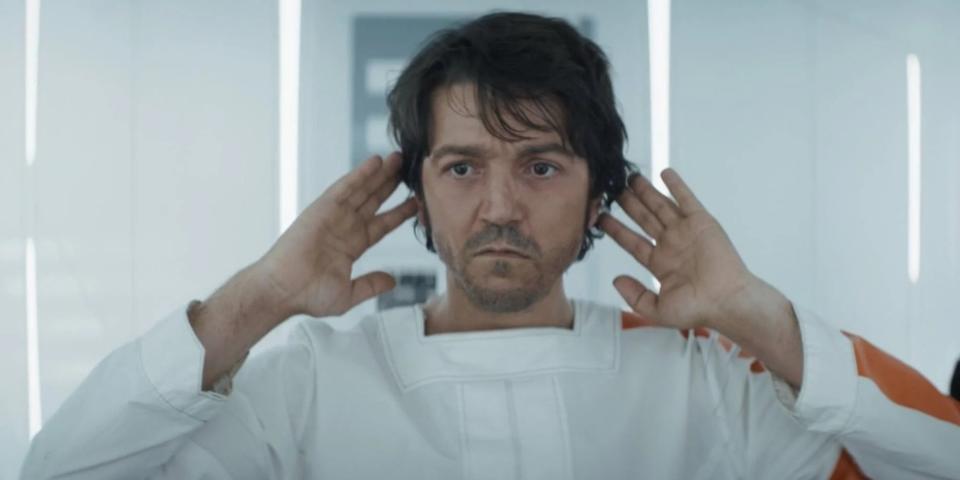Every Episode of ‘Andor’ Is a Trap

- Oops!Something went wrong.Please try again later.
The last three episodes of “Andor” featured a prison without bars, but part of both the thrill and the pathos of the latest “Star Wars” series is that Cassian Andor (Diego Luna) has felt like a captive of the Empire the entire time. Everyone in “Andor” is trapped, often visually through the sculpted, strong lines of Luke Hull’s incredible production design, and always through the eye of the camera, helmed in the first three episodes and Episodes 8 through 10 by director Toby Haynes.
The last full scene of Episode 10, a rare face-to-face meeting in which double-agent Lonni Jung (Robert Emms) tries to get out of the spy game with his handler, rebellion mastermind Luthen Rael (Stellan Skarsgård), Haynes and editor Simon Smith delight in jump cuts that snap closer and at slightly-off angles on Lonni. With the sick green light of the elevator rattling up the backwater towers of Coruscant, the ride up to meet Luthan feels like a panic attack.
More from IndieWire
Where Is 'Andor's' Massive Audience? Blame Disney for Too Many Bad 'Star Wars' Stories
Lucasfilm Announces Studio Ghibli Collaboration 'Zen - Grogu and Dust Bunnies'
“This was very much a show that was about the internal struggles of the characters as well as the external,” Haynes said of his philosophy toward organizing action and shooting “Star Wars” environments for “Andor.” No matter what a scene ultimately ends up being about, Haynes, along with his fellow directors Susanna White and Benjamin Caron, emphasize the oppression of the Empire through visual order and the ways characters relate to the spaces around them. Even Luthan, perfectly in control of the situation and sending Lonni back after verbally tearing apart his resignation, stands dwarfed by cavernous sci-fi arches and buffeted by wind on a lonely catwalk corridor to the elevator, poised on a razor’s edge in so many ways that the least noticeable one is the way that the frame’s laid out.

Screenshot/Disney+
Further up the skyline of Coruscant, in the literal height of imperial luxury, Senator Mon Mothma (Genevieve O’Reilly) is no less constrained by Haynes’ camera. “She is someone who is trapped in a gilded cage. Literally that set is a kind of testament to how imprisoned she is,” Haynes said. “So [that was] very much on my mind when I’m filming it and looking for opportunities to visually kind of sum up where a character is in their story arc. [That’s] the challenge of everyday filming.”
The subtle feeling that Mon only has inches to maneuver is present in the most ordinary of scenes, as in the one in Episode 10 where she sits down with Tay Kolma (Ben Miles) and Davo Sculdun (Richard Dillane) to hopefully solve the problem of hiding the funds she’s raising for the rebellion. The three sit on a circular gold couch a bit sunken into the floor, Mothma dead center and the two men to the extreme right and left. When Sculdun leverages the power he has to make a horrifying offer (of a marriage alliance between their two children), Haynes’ camera grabs the steely, shocked close up on O’Reilly’s face. But the last shot of the sequence places the camera at floor level, Tay’s feet obscuring Mon for a couple seconds before we see her, alone in the cavernous, white and gold room, looking for all the world like she is about to be swallowed up by a very posh Sarlacc pit.
Haynes continually finds ways to visually accentuate the spycraft-filled sharpness of Gilroy and Beau Willimon’s writing. Consider the end shot of Episode 8, which rises up above Bix (Adria Arjona), wrapped up in a metal cylinder as she futilely signals to Luthen from the very Imperial-occupied Ferrix. Two episodes later, we see Kino Loy (Andy Serkis) caught in a stream of bodies and already visually drowning as those he inspired run toward a long drop and an even longer swim to freedom he knows he won’t be able to reach. “Andor” has a clear thesis and point-of-view on the “Star Wars” universe, one the camera returns to again and again to emotionally explain why the Rebel Alliance will spring from the soul-destroying, sterile order of the Empire.

Disney+
“[Every scene] needs to feel like it’s really happening right now, right in front of your eyes, and we’re just lucky enough to glimpse it with the camera,” Haynes said. “That’s the feeling I want to get. And so when I come to set, I want to get it on its feet as quick as possible, see a rehearsal, and try and just sit there and watch it from as many angles and many positions as I can, and then look for those opportunities for how I can use the camera to tell the story.”
This wealth of angles and visual flexibility really helps give “Andor” its tone and feel, which is why it’s the first of the new “Star Wars” series not to take advantage of ILM’s StageCraft, the LED volume that helped make “The Mandorian” so transporting. “[The way ‘Andor’ shoots] really informs performance as well. I don’t think we could have done it in the same way if we were on the volume,” Haynes said.
“You can see that in the prison. They were stuck on that set, that corridor, the whole day, and they were all in bare feet. I tried it out myself. When you walk along that steel floor for the first time in bare feet, you feel vulnerable. The studio is not a friendly place for somebody who’s not wearing shoes, you know? There’s a lot of stuff that can fall on you. So they felt like they were very much at the mercy of the machine and they couldn’t run off and use their phones or anything. So it’s like they were stuck there and I think that really informed the performance.”

Disney+
The prison sequences on Narkina 5 throughout Episodes 8, 9, and 10 are a case study in all of the small ways that filmmakers can prompt the viewer to come to both intellectual and emotional realizations about the characters as a scene unfolds. Much of the work of Kino’s change of heart at the end of Episode 9 is in the quiet fury on Serkis’ face, but Haynes’ camera, after a long sequence of close, furtive over-the-shoulder angles and a habit of placing Kino in the left of frame, goes high and places him right — in perfect spatial alignment with Cassian — so that when he finally answers the question of how many guards there are on the floor, it feels like a small moment of triumph and not a surprise.
Kino’s address that prompts the other prisoners to revolt in Episode 10, however, is covered with fidgety handheld camerawork. It gradually smooths a bit as Kino finds his inspiration to speak from Cassian, but Haynes keeps Serkis’ closeups slightly off-center, or his entire head not quite in frame; the visual incompleteness and lack of symmetry, the way the camera needs to find his eyes again as his anger helps him pick up steam, is the perfect visual match for the arc of the monologue itself, the camera and the writing and the performance all working together to convey the power of Kino’s choices in this moment.
“I wanted to make sure it felt like you knew where you were just by the way that the camera is behaving,” Haynes said. “So you’ll see that in Episode 8, the camera is much more balletic and cinematic, much more Kubrickian in its shot logic, and then when you get to Episode 10, it’s very much more on its feet. It’s on the shoulder. It’s running around with the characters. You’re in the trenches with them, you’re running through it, and you could get shot at just as they could. That plants you right in their experience.”
That experiential focus also led to some wonderful additions on the day of shooting. When covering the scene in the control room where Cassian corners the guards and ushers the officer on duty (Martin Ware) away from the prison’s power supply, Haynes said, “It just sprang into my head to say, ‘Tell him to be on program!’ Because these guys have been saying ‘on program, on program,’ the whole time. And [Luna] was like, ‘On program motherfucker!’, like that, you know? He was just trying to get performance out of him.”
The team liked the moment so much they actually went back and re-shot the imperial side of it days later, so that Haynes could get the image of the scared guards complying.

Disney+
The “Andor” team is constantly finding small moments of visual action to help convey the story, and although there’s a thrilling, darkly bombastic quality to the prison sequences, some of Haynes’ favorite work on the show involved shooting the backstory for Cassian as a young boy named Kassa (Antonio Viña) on his homeworld of Kenari. It’s a wonderful departure for a “Star Wars” show, and yet it also feels like one that the franchise should’ve taken long ago: a tribe of young adults all speaking an alien language without subtitles. All the cues for what’s happening come from body language and facial expressions, camera movement and placement, and, like the wordless, evocative world-building detail of Ferrix’s favorite Bell Guy, the audience has just enough information to want to dive into the story.
“It really felt special,” Haynes said. “There was a moment in there when Cassian copies the young Alpha Girl (Malini Raman-Middleton) that wasn’t scripted. I needed something to show the connection between her and him. I always wanted them to put on sort of makeup to be a part of the sort of hunting party and there was some resistance about doing makeup because it would slow us down filming and we knew that we’d be really tight, but I was adamant about this moment. Kids, in a way, don’t act. And so you have to give him something to do and to be able to explain or to sort of show his interest in her.”
Kassa’s war paint is a wonderful marker both of that initial connection with the girl who dies in the hunting party, and across his scenes in Episodes 1 through 3. Over the course of the day and over the action of Kassa being taken by Maarva (Fiona Shaw) back onto her ship before the Imperials arrive, the warpaint fades. When he wakes up and gazes out the ship’s window as it rockets off-world, intercut with the adult Cassian being whisked away from Ferrix by Luthen, the paint and the way that Haynes frames those shots to be mirrors of each other, helps us visually track all the many heartbreaks of Cassian Andor across his life and across the stars. Episode 10 may be titled “One Way Out,” but even when traveling to safety, in “Andor” there’s really no way to escape the hand of the Empire. The only way out is through.
“Andor” is available on Disney+.
Best of IndieWire
The Best True Crime Streaming Now, from 'Unsolved Mysteries' to 'McMillions' to 'The Staircase'
'The Last of Us' Sets Early 2023 Release at HBO: Here's Everything You Need to Know
From 'Reality Bites' to 'Fatal Attraction,' Keep Track of All the Upcoming Film-to-TV Adaptations
Sign up for Indiewire's Newsletter. For the latest news, follow us on Facebook, Twitter, and Instagram.

